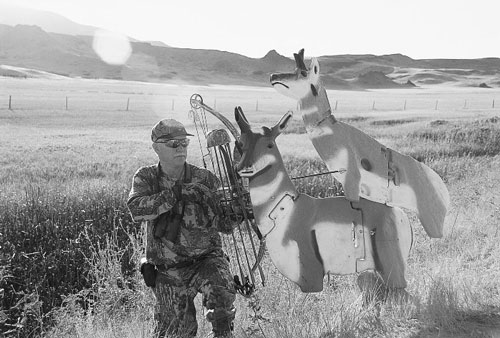Enter Mr. Big
At 3 p.m. I had been in the blind 90 minutes. I’d watched more than a dozen antelope, plus a rabbit that came crashing in the rear of the blind. Everything was on the move.
Suddenly, hooves pounded to the south and I reached for the bow, gripping the compound as another small buck came to drink. A buck approached from the north, then a third animal from the south. “When you see that big goat you’ll know it,” said Schearer prepping me for the chance at a really big antelope. Without doubt buck #3 was IT!.
Once before the tall-horned animal had walked past this blind within bow range, yet the archer wasn’t ready and could not take a shot. Bow in my grasp, I waited for the animal to stop. It walked immediately to the water, lowered its head, prompting my draw arm to come back. Before I could shoot, the buck began walking again, turning its rump toward me.
Had my window of opportunity closed in a mere second? Would the animal now drink directly facing me? Asserting its dominance, the monster buck continued to circle, forcing a lesser animal from the water.
The enormous horns were clearly having an effect on my concentration. My grip trembled as its head went down and my right arm came back. When the 20-yard pin settled behind the shoulder, I released.
The arrow hit home and the antelope jumped, took several steps, then looked back. My heart sank. “Had I missed?” I questioned, puzzled by the animal’s strange behavior. Then suddenly the goat broke into a full-speed run dodging right and left. In seconds it tumbled in a pile of dust.
Schearer checked my progress via spotting scope every half-hour and soon joined me for the photo and field-dressing event. “That’s one awesome goat,” he said, offering his congratulations. A tape showed that the animal measured 17 inches, with massive bases and blades. “That could be the biggest antelope taken in Montana this year with a bow,” he said seriously. “It will make Boone and Crockett for sure.
“You could be the luckiest hunter in Montana as well,” he added, having a little fun. “Thirty minutes last year, 90 minutes this year.”
“Hey! Just a minute, guy,” I countered, not giving him any slack. “It may be a B&C buck, but this year it took three times as long.” With that, we both had a good laugh, then got down to the business of transferring my trophy to table fare.
Sexy Decoy Strategy
 Had the waterhole blind been unsuccessful, our next tactic was a breeding-buck decoy. An archer from South Dakota tipped me to this ultra-infuriating tactic for pronghorns. The first time he and his buddy tried it, they took back-to-back goats on opening day. Basically, it’s a buck mounting a doe. Not only does seeing a rival animal breeding a doe antagonize a dominant buck, but the added decoy provides important concealment for the archer and a much more stable shooting position.
Had the waterhole blind been unsuccessful, our next tactic was a breeding-buck decoy. An archer from South Dakota tipped me to this ultra-infuriating tactic for pronghorns. The first time he and his buddy tried it, they took back-to-back goats on opening day. Basically, it’s a buck mounting a doe. Not only does seeing a rival animal breeding a doe antagonize a dominant buck, but the added decoy provides important concealment for the archer and a much more stable shooting position.
Also, doe replicas can be deployed as confidence decoys. One of Schearer’s hunters placed a doe decoy in an alfalfa field and hid behind it. An antelope buck approached to 43 yards, just beyond the archer’s comfortable shooting range. As a side benefit, dozens of deer approached “confidently,” and the archer arrowed a good muley buck. Using several doe decoys, just like duck decoys, should draw antelope like flies.
Finally, flexibility is the key to successful antelope hunting. Like the multiple-choice option, “all of the above” is the best strategy when matching strategies to productive conditions. Observe rutting activity carefully. Note the weather, travel patterns, fence crossings and food influences. Whichever tactic you choose, matching wits with this prairie speedster is a genuine rush.






